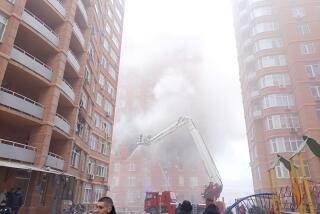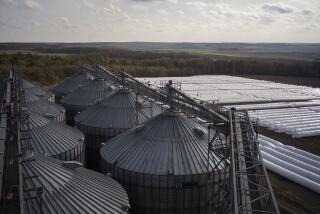Poison Mushrooms Take Toll in Ukraine
- Share via
KIEV, Ukraine — An old Ukrainian saying, “Don’t hunt for mushrooms unless you have luck,” has acquired new relevance with a rash of wild mushroom poisonings this season.
Despite repeated warnings on radio and television, up to 10 people a day are becoming severely ill or dying from toxic mushrooms. The toll during the current autumn harvest exceeds 1,500 poisonings and 101 deaths; nearly half the casualties are children.
For comparison, the Ukraine’s most dangerous contagious disease, diphtheria, has killed 70 people this year.
The poisonings have been concentrated in the east and south of Ukraine, where mushroom picking is not traditional, as it is elsewhere in Eastern Europe. These areas have the highest rates of poverty in the country, suggesting that the poor are supplementing their diets with free food where they can find it.
“People are raking mushrooms up by the bucket, without the slightest sense of self-preservation,” says Asiu Bukhalo, a botanist with the Ukrainian Academy of Sciences.
The results have been tragic. A 5-year-old girl died almost immediately after eating poisonous mushrooms, and her mother, who was rushed to the hospital for treatment, begged to go the funeral of her only child. She died at the cemetery.
Early this month, a government commission on emergencies devoted an entire meeting to the situation and chastised officials from the most afflicted regions for continuing to be ill-prepared even after dozens of deaths from mushroom poisoning during the 1995 season.
Media reports lay most of the blame on a common mushroom popularly known as the pale pagan, which looks much like a wild champignon to the untrained eye.
But Bukhalo isn’t certain that the pale pagan is the culprit, especially because it is rare in the regions that are hardest hit. He says that an unusually wet summer is more likely to blame.
In Crimea, which has less average annual rainfall than Los Angeles, the warmth and lack of moisture inhibit fungal growth in most of the peninsula. But this year’s cool and rainy summer brought out unusual mushroom varieties that haven’t been seen for many years.
“Even the experts can’t always tell what they are, “ Bukhalo says.
Of the 10,000 types of mushrooms in Ukraine, several hundred are edible but only about a dozen are commonly picked. Most of them grow in forests, which are found only in parts of western and northern Ukraine and the mountains of Crimea.
Although mushroom picking in the north declined after the 1986 disaster at the Chernobyl nuclear reactor--mushrooms practically vacuum radioactive cesium out of the soil--western Ukraine continues the age-old tradition. Probably because of the practical knowledge passed down through generations, there hasn’t been a single case of mushroom poisoning in the western part of the country.
The steppes of the east and south, however, lack those traditions and knowledge because woodlands were almost unknown until trees were planted for erosion barriers and parks after World War II.
“People can’t distinguish between edible and poisonous mushrooms,” says Bronislava Blaznieva, a health ministry expert.
Yet another reason, however, is old wives tales. In reprints of “The Old Ukrainian Kitchen” selling in Kiev bookstores, cooks are told that a silver spoon or onion placed in a broth will darken in the presence of a poisonous mushroom. When sliced, the cookbook advises, toxic varieties produce a milky liquid and make salt turn yellow.
Experienced mushroom pickers laugh at such false counsel. But this autumn’s death toll is a grim reminder that superstition still holds sway in many parts of the country.
More to Read
Sign up for Essential California
The most important California stories and recommendations in your inbox every morning.
You may occasionally receive promotional content from the Los Angeles Times.













